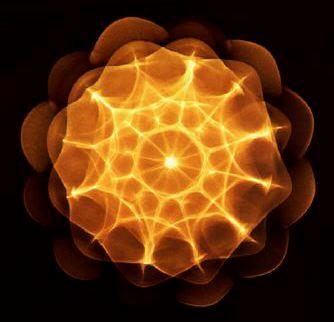| Cymatics and group formation | 2007-03-21 14:20 7 comments |
 by Flemming Funch by Flemming FunchCymatics is the study of wave phenomena. More specifically, the word is used to describe the production of physical patterns by making sound waves interact with a medium. You put some sand or powder on a surface, and make the surface vibrate with a certain frequency and wave form, and the material organizes itself into interesting patterns, like mandalas. Swiss scientist Hans Jenny studied that a lot, and coined the word cymatics for it. See youtube videos here, here, here or here. Some of them create stationary patterns, others, like #3, create a continuous flow. Now Max Sandor suggests that this would somehow apply to the study of how groups form and how they behave, and I think I agree. A group behaviour follows the same pattern as an acoustic resonance on loose particles (cymatics).But, now, those patterns are completely different depending on what the frequency is, and what the wave form is. Some produce nothing useful, and some produce amazingly intricate and beautiful patterns. Likewise, if you put a bunch of people together, sometimes nothing useful happens, and sometimes amazing synergies emerge. Understanding the keys would be very useful. What would be the equivalent of the sound wave for a group of people? I'm not sure. Obviously a group has a certain vibe, particularly a well functioning group. There's some kind of resonance thing going on. A good group will continue in a stable pattern, even when members leave and new ones arrive. Some groups would keep being the same group even if you replaced all the members. So, something is holding it together, and it isn't unreasonable to describe that as a wave of some kind. Except for that we can't hear it, so we seem to have no good way of knowing what kind of frequency or wave form, and how it really is created and sustained. But one could maybe reverse-engineer it a bit. Look at well-functioning groups, and try to establish what the pattern is. What kind of regions of activity do we see, and what is connecting them? Is there a central element, or a certain symmetry? Are the elements staying put, or cycling around in a certain way? And then maybe drawing some conclusions about what kind of vibe must be at work for that to happen. If it were well understood, it might well be found that it is relatively small things that change the vibe. If you perform a symphony, and somebody drops a stack of plates in one of the quiet parts, that sort of colors the whole thing. But if you did it in one of the louder crescendo parts, it wouldn't make much difference. Or, you might have heard of the "broken window syndrome". If there's neighborhood with just one broken window in one building, or one abandoned car, or something like that, the whole area is likely to end up as a run down, "bad" neighborhood. Because, somehow, people sub-consciously pick up the vibe, "Oh, this is the kind of place this is", and act accordingly, and it is contageous. In some French metro stations they play classical music over the speakers, and they spread a light perfumed scent everywhere. Because they've found that it drastically reduces crime and littering. Doesn't take much. In looking around for stuff on Hans Jenny, I also ran into this little article, from an Occult Design blog. See, this kind of thing with waves and patterns would be quite a magical thing if one masters it to any extent. Arranging things so that desirable things happen. A sort of feng shui. Move the receptionists desk 3 feet forward, and maybe a different resonance is formed. Would be worthwhile to know. |